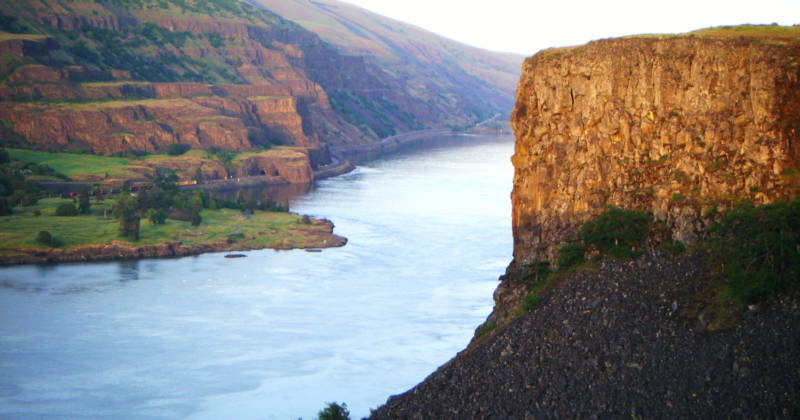This article on salmon’s spiritual significance to Inland Northwest Native Nations was published by the AP on August 15, 2022. Click here to read the full article from the AP, featuring photos and video.
By Deepa Bharath
August 15, 2022
ALONG THE COLUMBIA RIVER (AP) — James Kiona stands on a rocky ledge overlooking Lyle Falls where the water froths and rushes through steep canyon walls just before merging with the Columbia River. His silvery ponytail flutters in the wind, and a string of eagle claws adorns his neck.
Kiona has fished for Chinook salmon for decades on his family’s scaffold at the edge of the falls, using a dip net suspended from a 33-foot pole — like his father did before him, and his son will after.
“Fishing is an art and a spiritual practice,” says Kiona, a Yakama Nation elder. “You feel exhilaration in your body when you dip that net in the water and feel the fish. Then, you’re fighting the fish. The fish is fighting you, tearing holes in the net, jerking you off the scaffold.”
He finds strength, sanctity, even salvation in that struggle. The river saved Kiona when he returned from the war in Vietnam. As he battled addiction, depression and trauma, the river gave him therapy no hospital could.
When he lies on the rocks by the rushing river and closes his eyes, he hears the songs and the voices of his ancestors. The water, he says, holds the history of the land and his people.
“It heals you.”
From its headwaters in British Columbia where the Rocky Mountains crest, the Columbia River flows south into Washington state and then westward and into the Pacific Ocean at its mouth near Astoria, Oregon. Just below the confluence with the Snake River, the Columbia’s largest tributary, the river turns through the Cascade Mountain Range, carving out the Columbia River Gorge.
It’s a spectacular canyon, 80 miles long and up to 4,000 feet deep, with cliffs, ridges, streams and waterfalls. The landscape and colors change dramatically from the brown hills, shrubs and sagebrush at lower elevations to the lush greens of ponderosa pines, fir and larch trees higher up. Eagles and ospreys nest all along the river.
For thousands of years, Native tribes in this area have relied on Nch’i-Wána, or “the great river,” for its salmon and steelhead trout, and its surrounding areas for the fields bearing edible roots, medicinal herbs and berry bushes as well as the deer and elk whose meat and hides are used for food and ritual. That reliance transcends the material realm into the spiritual, as the acts of gathering, consuming and respecting those foods are inextricably linked to the tribes’ religious practice.
Yet the river is under threat. Warming waters linked to climate change endanger the salmon, which need cooler temperatures to survive. Hydroelectric dams on the Columbia and its tributaries have curtailed the river’s flow, further imperiling salmon’s migration from the Pacific upstream to their freshwater spawning grounds. Industrial pollution are also threats; testing by the Columbia Riverkeeper, a nonprofit that aims to protect water quality, shows that fish caught in the area are contaminated with flame retardants; polychlorinated biphenyls, or PCBs; and heavy metals.
Pollution and climate change are not only threatening the health of the river and its habitat, but also the millennia-old spiritual traditions that hold Native communities together.
Read the rest of the article on the AP’s website.

